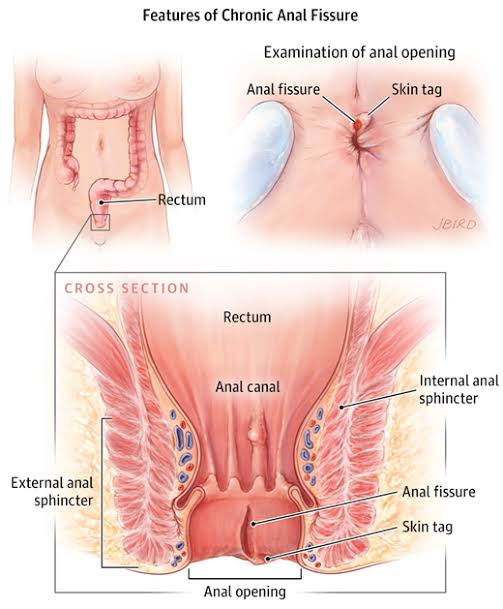
A fissure in ano, often referred to as an anal fissure, is a painful condition characterized by a small, longitudinal tear in the lining of the anus. This tear is mainly caused by passing hard stool. This discomforting issue is widespread among individuals nowadays, largely attributed to dietary choices and habits. It is a prevalent concern causing significant discomfort and inconvenience for those affected. Poor food choices and inadequate water intake are key contributors to the development of anal fissures. This type of tear can make daily activities such as sitting, walking, and using the bathroom a painful and challenging experience. While anal fissures are common and generally non-life-threatening, they can cause considerable distress and impact one’s quality of life. In this blog post our fissure expert doctor of Arogyam Piles Clinic and Research Center elaborate about the condition.
Sign and symptoms of anal fissure:-
Patients suffering from anal fissures commonly report experiencing intense pain during bowel movements. This pain can be brief or linger for several hours to even a full day. Some patients may notice bleeding while passing stools, which usually appears as a streak on the surface of the fecal matter or as a small amount of blood after defecation. In addition to pain and bleeding, individuals with anal fissures often describe feeling a burning sensation and itching in the affected area.
Cause of anal fissure:-
Anal fissures are often triggered by a variety of factors, with constipation being a primary culprit. The strain caused by passing hard, bulky stools can lead to tears in the sensitive lining of the anal canal. Additionally, chronic diarrhea can also contribute to the development of anal fissures by constantly irritating the area. Forcefully inserting objects into the anal canal can cause damage and increase the risk of fissures. In some cases, underlying health conditions such as hepatitis, HIV, or local skin diseases can also make individuals more susceptible to developing anal fissures.
Types of anal fissures:-
Anal fissures are categorized into two types based on from how long they are. An acute fissure is from less than three weeks. On the other hand, a chronic fissure is one that lingers beyond the three-week mark, persisting and causing ongoing issues for an extended period.
In another way to classify anal fissures, they are grouped based on where they’re located. This system breaks them down into two main types: primary and secondary anal fissures. Primary fissures are further categorized as either anterior (toward the front) or posterior (toward the back). Anything outside these two main spots is labeled as a secondary fissure. The most typical spot for an anal fissure to pop up is in the posterior region, right around the 6 o’clock position near the tailbone. The next most common location is in the anterior area, around the 12 o’clock position. Secondary fissures, on the other hand, are not as frequently seen and are usually linked to underlying health issues.
Anal fissure Treatment :-
The majority of anal fissures usually improve with conservative treatment, involving lifestyle adjustments and medicines. Diet plays a crucial role in managing fissures, requiring individuals to consume a high-fiber diet, stay well-hydrated, and maintain an active lifestyle. It is recommended to avoid refined foods, processed foods, caffeine, alcohol, and meat. In addition to diet modifications, physicians may suggest using laxatives and applying ointments locally. Patients are often advised to take hot sitz baths for relief. If conservative treatment proves ineffective, the next option is surgery, with the most common procedures being LIS, LASER, and fissurectomy employed nowadays.
Are you dealing with a stubborn fissure that just won’t go away with medication? If the thought of surgery makes you uneasy, worry not because Arogyam Piles Clinic and Research Center in Mohali, Chandigarh has got your back! They specialize in offering a non-surgical treatment for anal fissures known as kshar karma. During this procedure, a paste made from herbal medicines is gently applied to the fissure bed while you are under local anesthesia. This magical paste helps in shedding the dead margins of the fissure and kickstarting the healing process. So, if you’re on the lookout for a non-surgical fissure treatment in Chandigarh, don’t hesitate to schedule an appointment with our expert fissure treatment doctors at our facility in Mohali, Chandigarh.




